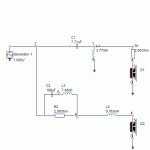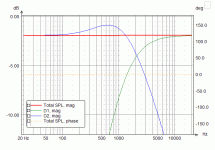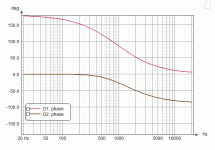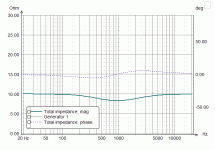What does it take to get good step response? (And time alignment I suppose)
I have read John Atkinsons article in Stereophile concerning speaker measurement and I was intrigued by the excellent step response of the Vandersteen seen here:
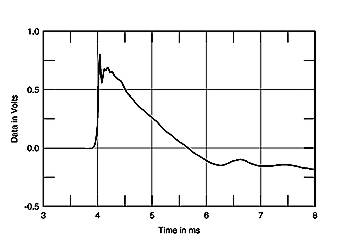
Having had quite a lot of listening experience with the Quad ELS67 which has a similar excellent step response and I was hoping to achieve something similar. You can say I am trying to catch some of the Quad magic without the drawbacks.
The Quad has no XO and the Vandersteen uses 1. order filters only - now assuming the higher frequency drivers are recessed or aligned with regard to the woofer - is 1. order filters the key to a good step response?
My own speakers have an asymmetrical 3. order/1. order network for the midrange-high frequency section at 800 hz, drivers connected in phase. The problem is that no matter how far back I move the high frequency section I still cant get a proper step-response. There seems to be two positive going peaks at all time, even though the last peak gets smaller af I move the tweeter back.
I am wondering if the 3. order/1. order network is the culprit here...
Does anyone here have knowledge about the subject?
Best
Kris
I have read John Atkinsons article in Stereophile concerning speaker measurement and I was intrigued by the excellent step response of the Vandersteen seen here:

Having had quite a lot of listening experience with the Quad ELS67 which has a similar excellent step response and I was hoping to achieve something similar. You can say I am trying to catch some of the Quad magic without the drawbacks.
The Quad has no XO and the Vandersteen uses 1. order filters only - now assuming the higher frequency drivers are recessed or aligned with regard to the woofer - is 1. order filters the key to a good step response?
My own speakers have an asymmetrical 3. order/1. order network for the midrange-high frequency section at 800 hz, drivers connected in phase. The problem is that no matter how far back I move the high frequency section I still cant get a proper step-response. There seems to be two positive going peaks at all time, even though the last peak gets smaller af I move the tweeter back.
I am wondering if the 3. order/1. order network is the culprit here...
Does anyone here have knowledge about the subject?
Best
Kris
far as I know, 1st order is the only way to go, followed by a tricky baakgard crossover (filler driver, used by B&O a while back).
24db, while touted as time alignment, is only aligned at the crossover point.
I have a old pair of thiels (6db, slanted baffle). They are good but lack in many other areas. Sometimes I use a pair of 4" run wide open with bass support, sometimes I cross them at 400hz (24db LR) to a pair of 15's, and most of the time I cross 15's to a compression driver (750hz @ 24db LR).
Norman
24db, while touted as time alignment, is only aligned at the crossover point.
I have a old pair of thiels (6db, slanted baffle). They are good but lack in many other areas. Sometimes I use a pair of 4" run wide open with bass support, sometimes I cross them at 400hz (24db LR) to a pair of 15's, and most of the time I cross 15's to a compression driver (750hz @ 24db LR).
Norman
STep response, impulse response, capability to reproduce a square wave
Thank you very much John,
I am going to read this article carefully again even though some of the math is beyond my current level of understanding.
I am willing to sacrifice perfectly flat frequency response in order to obtain better transient response and better time alignment.
I will post some measurements that apply to the midrange/high frequency section of my speakers. This section is passively filtered - the XO is ~800 Hz, asymmetrical electric slopes. It is easy to move the horn loaded tweeter section independently of the bass/mid driver.
Measurements will be posted at a later date. (As soon as possible).
Sincerely
Kris
STep response, impulse response, capability to reproduce a square wave are all dependent on the typ of crossover as well as the alignment of the drivers. See this article.
Thank you very much John,
I am going to read this article carefully again even though some of the math is beyond my current level of understanding.
I am willing to sacrifice perfectly flat frequency response in order to obtain better transient response and better time alignment.
I will post some measurements that apply to the midrange/high frequency section of my speakers. This section is passively filtered - the XO is ~800 Hz, asymmetrical electric slopes. It is easy to move the horn loaded tweeter section independently of the bass/mid driver.
Measurements will be posted at a later date. (As soon as possible).
Sincerely
Kris
There are actually many ways to achieve transient perfect crossovers. Theyt don't always lend themselves to passive desings though. Additionally it is difficuly to conclude what the audible effects are since in most cases the polare response of the system will also change. It in only when we get into the use of digital crossover and digiutals pahse correction that we can control the transient response without altering the polar. Then, and only then can a meaningful comparison be made.
...I am willing to sacrifice perfectly flat frequency response in order to obtain better transient response and better time alignment...
Mmmm, OK, but I think actually the two should go hand-in-hand.
My feeling is this is hugely dependent on choice of drivers. The drivers must be well behaved and lend themselves to a simpler crossover.
What Vandersteen model is that step for? Which Stereophile issue?
In a nutshell, you basically need 1st order crossovers on all drivers, and proper time alignment.
In reality, this can only be approximated as driver rolloffs, frequency dependent acoustic-centres, and falling off-axis responses make it virtually impossible to achieve.
Still, as a purist who believes simpler is usually better, it's something I aim for in my own designs.
In reality, this can only be approximated as driver rolloffs, frequency dependent acoustic-centres, and falling off-axis responses make it virtually impossible to achieve.
Still, as a purist who believes simpler is usually better, it's something I aim for in my own designs.
I would rather call this a constant voltage crossover. Yes, it gives the same response as a subtractive one but it does not work by subtraction.
The problem with this crossover is that you will end up with a huge dip in the frequency response as soon as you connect it to real drivers - simply because it doesn't take their response into consideration.
ACTIVE is the only way to implement constant voltage crossovers properly IMO.
Regards
Charles
The problem with this crossover is that you will end up with a huge dip in the frequency response as soon as you connect it to real drivers - simply because it doesn't take their response into consideration.
ACTIVE is the only way to implement constant voltage crossovers properly IMO.
Regards
Charles
- Status
- This old topic is closed. If you want to reopen this topic, contact a moderator using the "Report Post" button.
- Home
- Loudspeakers
- Multi-Way
- Questions about time alignment and step response
